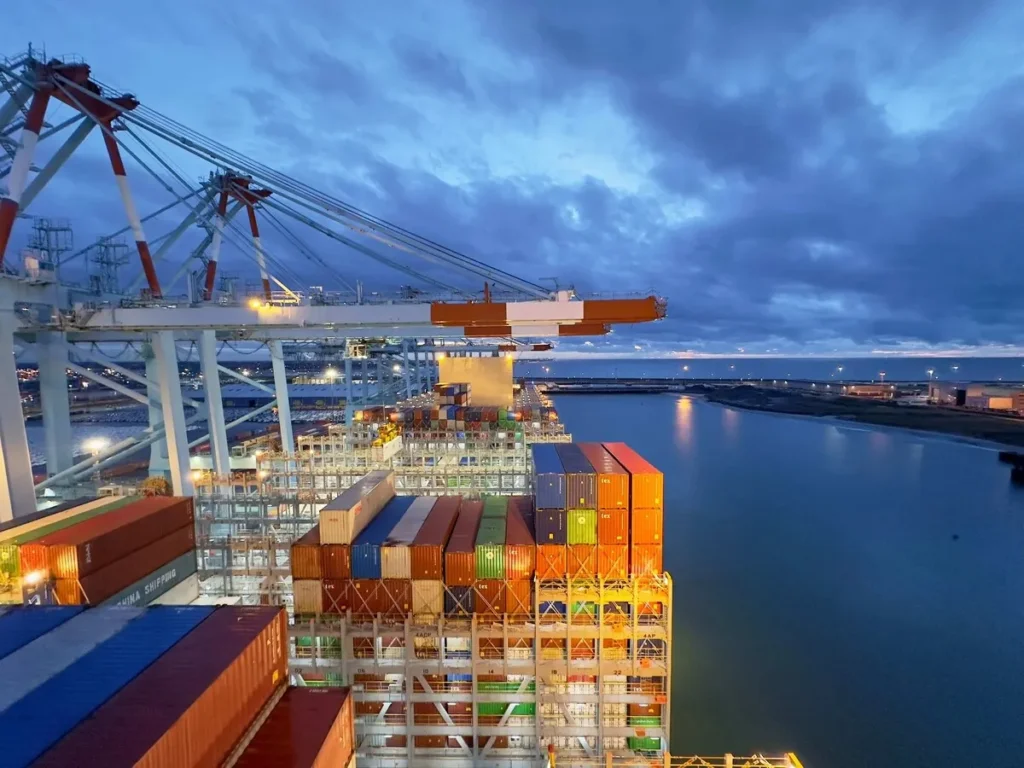Hamburger Hafen und Logistik AG (HHLA) closed 2024 with a 10.5% increase in revenue, reaching €1.598 billion. The company’s EBIT rose by 22.7% to €134 million, with net income after minority interests growing to €33 million, a significant rise from €20 million in 2023. The publicly listed Port Logistics subgroup recorded a 26.8% rise in EBIT, reaching €118 million.
“Despite ongoing geopolitical instability, recession in Germany, and supply chain disruptions, we consistently pushed ahead with the strategic development of HHLA in 2024. The targeted expansion of our European network in particular had a positive effect on our revenue and earnings,” said Angela Titzrath, Chief Executive Officer of HHLA.
In contrast, the Port of Antwerp-Bruges focused on throughput expansion rather than revenue figures. The port reported a 2.3% increase in total throughput, reaching 278 million tonnes, driven by strong growth in container volumes.
This growth was largely driven by container handling, which saw an 8.9% increase in tonnage and an 8.1% rise in TEU volume. Additionally, the port’s market share in the Hamburg-Le Havre range grew by 0.7 percentage points to 30.6% in the first nine months of 2024.
However, total cargo throughput at Antwerp-Bruges was 278 million tonnes in 2024, representing a 2.3% increase compared to the previous year.

“Over the past year, we have once again demonstrated our resilience. More than ever, the challenges we face, such as geopolitical tensions, the energy transition, and complex permit processes, require cross-border cooperation and a shared vision. Only then will we remain attractive to investors and maintain our strategic role as a pioneer in the industry,” stressed Jacques Vandermeiren, CEO of Port of Antwerp-Bruges.
Container throughput and capacity growth
Container throughput played a pivotal role in the performance of both ports. HHLA’s seaport container handling grew slightly by 0.9% to 5.97 million TEU, while the intermodal segment saw a notable 11.6% increase, reaching 1.787 million TEU. Antwerp-Bruges saw even stronger growth, with its container segment expanding by 8.1% in TEUs, bolstered by a 9.2% increase in reefer container traffic.
Bulk cargo performance was more mixed. HHLA did not highlight bulk cargo figures, whereas Antwerp-Bruges reported a 0.4% rise in dry bulk, despite a sharp 35.4% decline in coal throughput. Fertiliser throughput, however, surged by 22.9%, compensating for other shortfalls. Liquid bulk declined by 5.8%, primarily due to lower demand for diesel (-22.3%) and LNG (-21.9%), though chemical throughput increased by 14.8%, driven by rising biofuel shipments (+60.1%).
In RoRo traffic, Antwerp-Bruges recorded a 3.4% decline, mainly due to a 10.3% drop in automotive throughput.
Both ports navigated a challenging economic environment, including high energy prices, supply chain disruptions, and geopolitical instability. HHLA noted that despite recessionary pressures in Germany, it successfully expanded its European network, which contributed positively to revenue and earnings.
Meanwhile, Antwerp-Bruges faced challenges in the construction, chemicals, and automotive sectors, while geopolitical tensions in the Red Sea led to longer shipping times and uncertainty in international trade.
2024 infrastructure and sustainability initiatives
Both ports continued investing in infrastructure and sustainability:
- HHLA: Expansion of its European transport network and increased storage charges due to longer container dwell times helped drive financial growth.
- Antwerp-Bruges: The introduction of a 16-meter draught in 2024 enhanced its competitiveness, with Zeebrugge achieving a record 16.3-meter draught. Other developments include:
– NextGen District and NextGen Demo initiatives supporting the circular economy.
– Methanol bunkering for deep-sea vessels as part of its multi-fuel strategy.
– Deployment of shore power projects in Antwerp and Zeebrugge to reduce emissions.
– Launch of one of Europe’s largest public charging stations for electric trucks.
– Continued fleet sustainability efforts, including the Volta 1 (all-electric tug) and Methatug (methanol-powered tug).
2025 plans: improving infrastructure and expanding capacity expansion
Looking ahead, both ports face a mix of challenges and opportunities. HHLA must navigate Germany’s economic slowdown while continuing its intermodal expansion. Antwerp-Bruges will focus on capacity expansion, sustainability investments, and strengthening its international position. Key priorities include increasing security, further integrating sustainable technologies, and ensuring its role in global supply chains amid ongoing geopolitical uncertainties.
“The complementarity of our port platforms has once again proven to offer great added value. We continue to invest in critical infrastructure, such as the renewal of Zweedse Kaai with shore power for cruise ships. Our focus remains on sustainable growth and maintaining our strategic position as a world port,” noted Dirk De fauw, Mayor of Bruges and Vice President of Port of Antwerp-Bruges.








